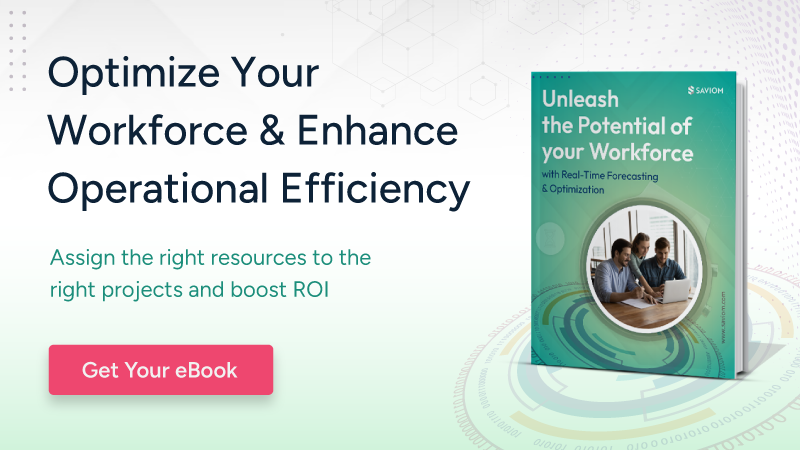Are you struggling to control increasing operational costs due to inefficient processes and resource wastage?
Is maintaining consistency and quality in your products/services a persistent issue for your firm?
Are you finding it difficult to maintain operational standards and meet the industry benchmarks?
Improving operational efficiency is the solution to the above problems. However, it is easier said than done. Factors like inefficient resource management, poor communication, outdated technology, and lack of process standardization adversely affect operational efficiency in organizations, resulting in reduced profitability.
Thus, firms must identify these bottlenecks and implement appropriate measures to enhance operational efficiency and drive sustainable growth.
Read this blog to discover the best strategies managers can implement to boost operational efficiency in your firm.
But before that, let’s delve into the nitty-gritty of operational efficiency in detail.
What is Operational Efficiency?
Operational efficiency refers to the organization’s ability to deliver products or services to its customers in the most cost-effective manner while maintaining high-quality standards. This involves optimizing resources, such as time, labor, and materials, to achieve the best output with minimal waste.
Let us go through some real-life examples to get a clear understanding of operational efficiency.
Operational Efficiency Examples:
Toyota Production System (Automotive Industry)
A classic example of operational efficiency is the Toyota company, which revolutionized the automotive industry with its lean manufacturing principles, known as the Toyota Production System (TPS). This system focuses on eliminating waste, improving quality, and reducing production costs.
Southwest Airlines (Aviation Industry)
Southwest Airlines has achieved high levels of operational efficiency, allowing it to offer low-cost fares to customers. The key strategy includes operating a single aircraft model (Boeing 737) to simplify maintenance and training. Further, the airline uses a point-to-point route system rather than the traditional hub-and-spoke model. This helps the company minimize flight delays and reduce operating costs.
Amazon’s Fulfillment Centers (E-commerce Industry)
Amazon’s fulfillment centers are very famous for their operational efficiency strategies. By leveraging advanced robotics, automation, and sophisticated inventory management systems, Amazon can process, pick, pack, and ship orders quickly and accurately. The company also uses real-time data analytics that helps optimize inventory levels and reduce shipment delivery time, thereby enhancing customer satisfaction and ARR.
Now, let’s understand the significance of operational efficiency.
Read More: 7 Steps to Build a Winning Operational Strategy for Your Business
Benefits of Operational Efficiency
Studies show that companies with high operational efficiency can see more sales revenues and profit margins than their less efficient counterparts.
This means that in today’s business landscape, achieving higher operational efficiency is no longer an option; it is a necessity. The following points highlight the major advantages of improving operational efficiency in organizations.
Reduces Operational Costs
Operational efficiency drives cost savings by streamlining processes and optimizing resource use. Additionally, companies can minimize waste, eliminate redundant tasks, and improve inventory management to significantly lower materials, labor, and overhead expenses. The adoption of new technologies to improve existing workflows also contributes to reducing overall operational costs.
Facilitates Informed Decision-Making
Streamlined processes and modern technologies provide better access to accurate and timely data. These real-time insights into performance metrics, customer behavior, and market trends enable decision-makers to make strategic choices. Enhanced data analytics and reporting tools allow organizations to identify emerging opportunities and potential risks more quickly, enabling businesses to adjust their strategies proactively.
Increases Productivity & Employee Engagement
“As per McKinsey report, companies that focus on people & performance have witnessed a surge in revenue by 30% and reduction in attrition rate by 5%.”
By eliminating redundant and time-consuming tasks, organizations can redirect resources to more meaningful, value-driven work. When employees work in a positive environment where their efforts are aligned with business goals, they experience greater job satisfaction. This boosts morale and encourages higher levels of employee engagement, ultimately leading to improved performance.
Boosts Business Profitability & ROI
By streamlining workflows and leveraging advanced technologies, companies reduce errors and minimize rework, leading to high-quality products and satisfied customers. This gradually turns into repeat business, thereby driving profitability. Additionally, operational efficiency provides agility to adapt to market demands and seize new opportunities. This improves ROI, resulting in long-term financial growth.
Next, let’s go through the difference between operational efficiency and productivity.
Operational Efficiency vs. Productivity: The Difference
Operational efficiency and productivity are often used interchangeably because both represent business performance.
But did you know that while they go hand in hand, there is a slight difference between the two? Let’s dive in and explore these differences:
ExampleA software development team ‘A’ delivers a project using 15% less time and budget than another team ‘B’ while maintaining the same level of quality. Then, team A is more efficient. Having understood the difference, we’ll now delve into critical aspects that drive efficiency.
| SL No. | Parameter | Operational Efficiency | Productivity |
|---|---|---|---|
| 1. | Definition | Efficiency refers to the optimal use of resources & time to achieve desired results. | Productivity refers to the work accomplished within a certain period. |
| 2. | Area of Focus | Minimizing waste & maximizing resource utilization. | Maximizing the volume of output or work completed. |
| 3. | Impact on Business | Reduces costs and increases profitability by using resources wisely. | Increases overall output to drive revenue growth. |
| 4. | Example | A software development team ‘A’ delivers a project using 15% less time and budget than another team ‘B’ while maintaining the same level of quality. Then, team A is more efficient. | A software development team ‘A’ completes 8 features in a sprint, while another team ‘B’ completes 6 in the same timeframe. Then Team A is more productive than Team B. |
Key Factors That Influence Operational Efficiency
Numerous factors influence operational efficiency. Enlisted below are the most critical ones:
- Process Optimization – Process optimization helps in removing redundancy in various operational workflows and procedures. It enables organizations to design, optimize, and implement standardized protocols and processes that consistently deliver the highest quality results. Therefore, process optimization contributes to cost reduction, faster turnaround times, and better organizational efficiency.
- Technology Integration – When companies incorporate advanced tools and technologies into their digital infrastructure, it augments workforce productivity and optimizes production or service lifecycle. These modern solutions help create lean processes, automate repetitive tasks, provide real-time data, and reduce resource wastage.
- Resource Management – A well-defined resource management process helps organizations utilize various business assets (human and non-human) effectively. By optimizing workforce productivity and equipment utilization, companies can cut down on resourcing costs, boost production, and improve operational performance.
- Supply Chain Management – Efficient supply chain management helps companies deliver the final product or service to the end user cost-effectively. Boosting supply chain efficiency allows businesses to reduce logistics costs, improve daily operations, enhance deliverables quality, and increase customer trust.
- Inventory Management – Proper inventory management enables companies to optimize stock levels, ensuring both product availability and cost efficiency. It minimizes the impact of downtime on production and distribution. Besides, it helps reduce wastage by maintaining sustainable inventory levels.
- Data Analysis and Decision-Making – Data analysis allows organizations to identify patterns in structured and unstructured data. It helps them understand consumer behavior, seasonal trends, market risks, etc. As a result, it empowers them to make informed decisions about day-to-day operations.
- Financial Management – Smart financial management is key to enhancing operations and scaling business. These financial strategies can help companies identify operational areas where costs can be reduced without compromising the quality of the final product. It can also help divert spending from unnecessary processes to more critical functions, thereby improving operational efficiency.
Next, we will understand how to measure operational efficiency.
Read More: What is Operational Planning: Definition, Key Benefits, & Tips to Create an Efficient One
How to Measure Operational Efficiency?
In business settings, operational efficiency serves as a performance indicator for how well an organization is doing. Thus, measuring operational efficiency helps these companies assess where they are lacking and how to improve.
Given below are the step-by-step process to measure it:
Identify Goals and KPIs
The first step in this process is establishing the operational goals and identifying critical KPIs that are worth tracking. Doing so helps companies focus their efforts on specific, achievable targets within a pre-defined timeframe. Moreover, the KPIs provide a baseline to help track progress and measure improvements.
For instance, a manufacturing company aims to increase the gross profit margin from 45% to 60% in the next financial year. Accordingly, the company establishes the KPIs to track and optimize to achieve the target. The identified metrics include sales revenue and cost of goods sold.
Collect Necessary Data
The next step is to gather relevant operational data. Then, they must ensure that data is collected in a standardized format, using automated systems to minimize errors and ensure consistency. This data will provide insights into how well the organization performs against its KPIs.
Continuing with the above example, from the financial records, managers collect relevant data like revenue and cost of goods sold (COGS). Let’s assume the revenue was $1,000,000, and the COGS was $550,000. Therefore,
Current Gross profit margin = ((Revenue – COGS)/Revenue) x 100 = (($1,000,000 – $550,000)/ $1,000,000) x 100 = 45%
So, to increase the gross profit margin, the company must look for opportunities to reduce COGS, as higher COGS indicates lower margins.
Analyze Current Workflows and Identify Performance Gaps
In this step, the organization must examine its current workflow and critical processes. By mapping out each step of the process, companies can identify potential bottlenecks, redundancies, & areas of improvement and take necessary steps to mitigate them. This enhances the overall productivity and performance of the company.
Considering our example, the manufacturing company analyzes the current workflow & identifies Inefficiencies like recurrent machine downtime during production setup and higher defect rates while assembling. To rectify this, the company can upgrade the machines and implement a total quality management system to reduce COGS and increase turnaround times. The expected outcome from this:
• Revenue = $1,000,000
• Current COGS = $550,000
• Expected COGS = $400,000
Then, Gross profit margin = (($1,000,000 – $400,000)/ $1,000,000) x 100 = 60%
Thus, the gross profit margin has increased by 15%.
Now, let’s go through the best strategies to enhance operational efficiency in organizations.
Read More: Top 15 Operational Metrics That a Business Should Monitor
7 Best Strategies to Improve Operational Efficiency in Firms
Improving operational efficiency offers a multitude of benefits, as discussed before. But how can one achieve it?
Given below are some of the best strategies for the same:
Integrate Technology to Streamline Processes
For any organization, regardless of size, streamlining internal processes is the first and foremost step in achieving higher operational efficiency. By leveraging the right tools and technologies, companies can maximize resource utilization, enhance process accuracy, and boost productivity.
These tools help automate repetitive tasks, which can significantly reduce employees’ workload and help them focus on more strategic initiatives. It can also help identify and eliminate wasteful processes while ensuring regulatory compliance. This saves time, effort, and money and improves daily operations.
Monitor and Control Operational Expenses
Companies must constantly track operating expenses to analyze spending patterns, identify cost drivers, and determine areas where expenditure can be reduced. They must categorize all expenses into fixed, variable, and discretionary costs. By closely examining expense categories, businesses can pinpoint areas where they can optimize costs without compromising the quality of their products or services.
Moreover, they must regularly review financial reports such as income statements, balance sheets, and cash flow statements to assess the company’s health and identify areas of concern or opportunities for improvement. Such regular retrospection helps eliminate wasteful spending, optimize operational costs, and create more realistic operational budgets in the future.
Manage and Utilize Resources Effectively
Companies must manage and utilize their resources effectively to maximize operational efficiency. This involves optimizing the allocation and use of tangible and intangible assets across all functional areas intelligently and cost-effectively. To achieve this, organizations can invest in robust resource management software.
These modern solutions offer a holistic view of all resources and their attributes, allowing managers to allocate them to various activities optimally. It also provides advanced functionalities such as forecasting, capacity planning, scenario planning, and real-time reports, enabling organizations to forward plan and optimize resource utilization.
Read More: What is Resource Utilization? A Complete Guide to Improve Business Efficiency
Implement TQM to Maintain High Standards and Quality
Implementing Total Quality Management (TQM) enables companies to improve the quality of their products or services through consistent process improvement. It allows them to detect and minimize expensive errors and waste throughout the various stages of the supply chain. For a successful TQM process, organizations must first identify the critical success factor (CSF) and define the metrics to track it.
Then, they must establish key customer groups and solicit their feedback through surveys. This information would serve as baseline data on the customers’ perception of current practices. Accordingly, companies can implement necessary changes in their processes and train the staff to improve the overall quality of their offerings.
Offer Multi-skill Building Opportunities to Resources
“According to the Workplace Learning Report, upskilling a current employee is much less expensive than hiring new ones as per 79% L&D experts.”
Companies must offer diverse training and development opportunities to their employees to upgrade their skills, diversify their knowledge, and keep them abreast of the latest technological trends. They can provide multi-skill building training to equip the workforce with multiple competencies.
Having multi-skilled employees helps companies deploy these resources to various activities across numerous functional areas, eliminating the need to hire new people for every task. This allows them to complete more work with fewer resources. Thus, investing in employee development boosts workforce productivity and lowers overhead costs, resulting in better operational efficiency.
Invest in R&D to Innovate and Stay Competitive
Investing in research and development empowers companies to improve their existing offerings and build new products. Therefore, it is not just an expense but an opportunity to innovate and stay ahead of the competition.
R&D activities also focus on improving internal processes and operational efficiency. By investing in R&D, businesses can identify inefficiencies, streamline workflows, and implement innovative technologies to enhance productivity. This results in lower operational costs, faster delivery cycles, and greater profitability.
Make Informed Decisions Using Real-Time Insights
Organizations must gather real-time operational data for informed decision-making. These valuable, actionable insights help businesses shape their processes and business strategies. It can help companies analyze customer behavior, identify market trends, and implement industry best practices to enhance operational efficiency.
To collect the relevant data in real-time, companies must establish their operational metrics and track them appropriately. These KPIs offer granular insights that will help identify bottlenecks and areas of improvement, assisting firms in making informed decisions. This will create new business opportunities, optimize workflows, and offer better risk management.
Read More: How to Improve Operational Efficiency in Your Firm?
Final Thoughts
Enhancing operational efficiency is paramount for any business to survive in today’s dynamic market. It offers companies a competitive advantage by providing the best results with fewer resources.
By following the best strategies mentioned above, businesses can improve their operational efficiency, boost profitability and ROI, and drive sustainable growth.
The Glossary
Read more: Glossary of Resource Workforce Planning, Scheduling and Management
The SAVIOM Solution
SAVIOM is undoubtedly the market leader in offering the most powerful and configurable Enterprise Resource Management Solution. Having more than 20 years of experience, this Australian-based MNC has a global presence in over 50 countries. It is also popular with more than 100 customers and helps them to achieve their business goals. SAVIOM also has products for project portfolio management, professional service automation, and workforce planning software which can be easily customized per business requirements.










